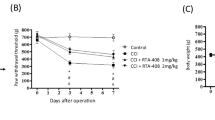Abstract:
Objective: The present study was designed to examine the involvement of bradykinin in thermal and mechanical hyperalgesia induced by chronic constriction nerve injury (CCI) using B1 and B2 receptor antagonists and mutant kininogen-deficient rats. Methods: Sprague-Dawley (SD) rats and Brown Norway (B/N-) rats given CCI treatment on day 0, were used as a model of neuropathic pain. Either a kinin B1 antagonist des-Arg9-[Leu8]-bradykinin or the receptor B2 antagonist HOE-140 was constantly infused into the left jugular vein of SD rats on days 15 to 22 after CCI. Vehicle-treated rats and sham-operated rats without nerve injury were also prepared as controls. In all rats, we observed pain behavior, and measured the latency period of paw withdrawal from the thermal stimuli and, with von Frey filaments, the mechanical pain threshold, before surgery and on days 14 and 22 after CCI. B/N-Katholiek rats, which congenitally lack plasma kininogen and release no kinin, were also tested for hyperalgesic parameters. Expression of kinin receptor mRNA in the dorsal root ganglia was detected by RT-PCR. Results: Most of the rats (88%)showed some pain behavior, which was reduced to 67% by a B1 antagonist and to 57% by a B2 antagonist infused between days 15 to 22. Thermal hyperalgesia was significantly reduced from 7.25 ± 0.41 sec (mean ± SEM) to 8.36 ± 0.41 sec in paw withdrawal latency on day 22 by a B1 antagonist and from 7.24 ± 0.19 sec to 8.23 ± 0.21 sec by a B2 antagonist (P < 0.05). Mechanical hyperalgesia was also ameliorated from 0.02 ± 0.007 g force to 0.16 ± 0.08 g force in pain threshold by a B1 antagonist and from 0.03 ± 0.007 g force to 0.10 ± 0.003 g force on day 22 by a B2 antagonist. Moreover, deficient B/N-Katholiek rats showed a low incidence of thermal and mechanical hyperalgesia on day 14. Expression of both B1 and B2 receptor mRNAs was detected in the lumbar dorsal ganglia ipsilateral to the site of the ner ve injury. Conclusion: These data suggests that kinin were at least partly involved in yielding nociceptor hypersensitivity up to day 14 after CCI. Bradykinin and its B1 and B2 receptors were involved in the maintenance of hyperalgesia.
Similar content being viewed by others
Author information
Authors and Affiliations
Additional information
Received 5 October 2002; returned 10 November 2002; returned for final revision 2 December 2002; accepted by M. Katori 6 December 2002
RID="*"
ID="*"Correspondence to: I. Hayashi
Rights and permissions
About this article
Cite this article
Yamaguchi-Sase, S., Hayashi, I., Okamoto, H. et al. Amelioration of hyperalgesia by kinin receptor antagonists or kininogen deficiency in chronic constriction nerve injury in rats. Inflamm. res. 52, 164–169 (2003). https://doi.org/10.1007/s000110300067
Issue Date:
DOI: https://doi.org/10.1007/s000110300067




